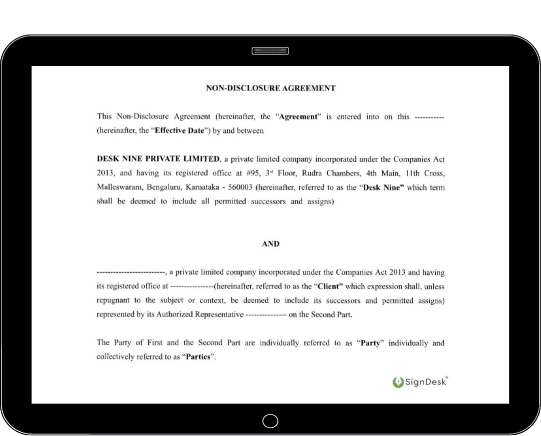Types of NDAs: Understanding the Different Agreements
There are several types of NDAs, each tailored to different situations:
Unilateral NDA
In a unilateral NDA, only one party discloses information that needs protection. For example, if a business hires a contractor to work on a sensitive project, the business (disclosing party) may ask the contractor (receiving party) to sign a unilateral NDA to protect its proprietary information.
Mutual NDA
In a mutual NDA, both parties share confidential information. This type of NDA is common in partnerships or mergers where both parties need to protect sensitive information exchanged during discussions. Mutual NDAs are common in partnerships, joint ventures, or negotiations.
Multilateral NDA
A multilateral NDA involves three or more parties. This type is helpful in cases where multiple organizations come together for a project requiring a collective effort. Instead of creating separate NDAs for each party, a single multilateral NDA streamlines the process and binds everyone to the same confidentiality terms.
Key Components of an NDA: What Should Be Included
Each NDA contains critical elements that clarify what information is protected, how long the protection lasts, and what happens if someone breaks the agreement.
Key Components of an NDA: What Should Be Included
Each NDA contains critical elements that clarify what information is protected, how long the protection lasts, and what happens if someone breaks the agreement.
NDA Enforcement: What Happens If You Break an NDA?
In India, breaking an NDA can have serious consequences. So, it’s essential to understand what constitutes a breach, the legal recourse available, and how businesses can proactively manage NDAs to prevent violations.
What Constitutes a Breach of NDA?
A breach of NDA occurs when a party shares, uses, or otherwise discloses protected information in a way that violates the agreement’s terms. In India, an NDA breach typically includes:
Unauthorized Disclosure
Sharing confidential information with external parties or within unauthorized internal teams
Misuse of Information
Using confidential data in ways not permitted under the NDA, such as using a partner’s data to create a competing product
Failure to Secure Confidential Data
Not taking appropriate measures to keep the information secure, leading to accidental disclosures
Each NDA breach is evaluated based on the contract’s terms, the nature of the information disclosed, and the damages caused by the violation.
Legal Actions Following
an NDA Breach
If an NDA is breached, the affected party has several legal options to pursue enforcement and compensation. Here are the primary legal actions available in India:
NDAs in India are considered contracts and fall under the Indian Contract Act of 1872.
If an NDA meets the requirements of the Act, it is deemed legally enforceable.
Breach of an NDA allows the aggrieved party to claim damages under Sect. 73 & 74 of the act.
Additional remedies can be sought under the Information Technology Act of 2000.
NDA Enforcement: What Happens If You Break an NDA?
In India, breaking an NDA can have serious consequences. So, it’s essential to understand what constitutes a breach, the legal recourse available, and how businesses can proactively manage NDAs to prevent violations.
What Constitutes a Breach of NDA?
A breach of NDA occurs when a party shares, uses, or otherwise discloses protected information in a way that violates the agreement’s terms. In India, an NDA breach typically includes:
Unauthorized Disclosure
Sharing confidential information with external parties or within unauthorized internal teams
Misuse of Information
Using confidential data in ways not permitted under the NDA, such as using a partner’s data to create a competing product
Failure to Secure Confidential Data
Not taking appropriate measures to keep the information secure, leading to accidental disclosures
Each NDA breach is evaluated based on the contract’s terms, the nature of the information disclosed, and the damages caused by the violation.
Legal Actions Following an NDA Breach
If an NDA is breached, the affected party has several legal options to pursue enforcement and compensation. Here are the primary legal actions available in India:
NDAs in India are considered contracts and fall under the Indian Contract Act of 1872.
If an NDA meets the requirements of the Act, it is deemed legally enforceable.
Breach of an NDA allows the aggrieved party to claim damages under Sect. 73 & 74 of the act.
Additional remedies can be sought under the Information Technology Act of 2000.
Using SignDesk CLM Software To Streamline NDA Management
Proactively managing NDAs can significantly reduce the risk of breaches. Contract Lifecycle Management (CLM) software, like SignDesk CLM, offers a comprehensive approach to simplify NDA management, reducing errors and ensuring all contracts are handled securely and efficiently.
Using SignDesk CLM Software To Streamline NDA Management
Proactively managing NDAs can significantly reduce the risk of breaches. Contract Lifecycle Management (CLM) software, like SignDesk CLM, offers a comprehensive approach to simplify NDA management, reducing errors and ensuring all contracts are handled securely and efficiently.
In summary, NDAs are essential for protecting sensitive information, but managing them effectively requires attention to detail and the right tools. With the help of efficient Contract Lifecycle Management software like SignDesk’s CLM, businesses can streamline NDA workflows, reduce errors, and enhance contract compliance.
Try CLM demo now




